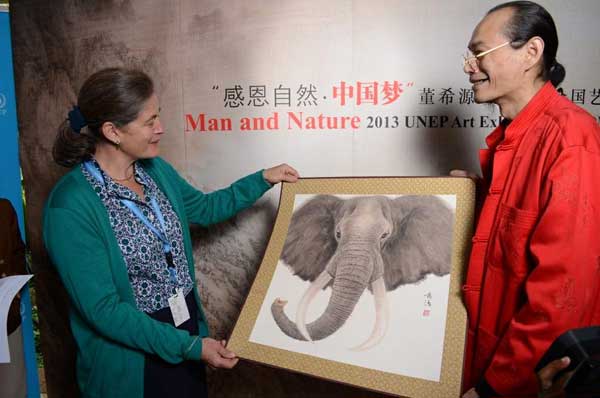Scroll artist redefines 'the big picture'
 0 Comment(s)
0 Comment(s) Print
Print E-mail China Daily, August 20, 2013
E-mail China Daily, August 20, 2013
|
|
|
Dong Xiyuan presents his artworks at an exhibition, Man and Nature, at the United Nations Environment Programme in Nairobi, Kenya. Photos provided to China Daily |
"I dare not say that I paint every day of the year, but it's almost like that," says Dong. His day usually starts in the afternoon and ends in the early morning of the next day, painting continuously except during mealtimes.
Most of Dong's pieces are landscapes of towering mountains dotted with trees and veiled in fog — a classical form that is the ideal of Chinese painting. He also paints animals, birds and flowers — common features of Chinese painting.
On the 42nd World Environment Day in June, Dong was invited to present an exhibition, Man and Nature, at the United Nations Environment Programme in Nairobi, Kenya. The show featured 48 Chinese ink paintings and a series of animals painted for the show.
The 10 animals were from Africa, including African elephant and rhino, and from China, such as the giant panda and the golden monkey. Dong paints the heads of all the animals in close-up views to show their vivid facial expressions.
"I depict the animal heads in large size to force an awakening of people's consciousness of environmental protection," says Dong.
Chinese painting has drawn its themes from landscapes, flowers, birds, fish and insects since the Song and Yuan dynasties (960-1368). So it's no wonder most Chinese artists have a love for the nature, says Dong.
"The ideology of Chinese philosophy stresses that humans are an integral part of nature. So this kind of theory shows itself in my paintings," says the painter.
To stay connected with nature, Dong spends two to three months each year exploring the wilderness. He usually sets up a big easel before a scene and spends days drawing the scenery. It's common for him to stay in the mountains for weeks.
The biggest easel he ever set before a scene was 1.2 meters long and 2.4 meters high, while the biggest picture he has created at his studio is 27 meters long and 2.3 meters high.






